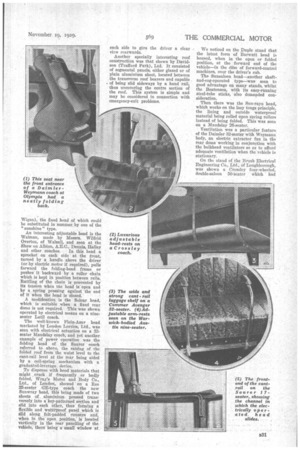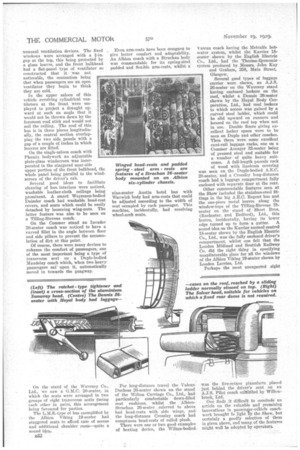The Coachbuilder's Effort to IMPROVE THE PASSENGER VEHICLE
Page 64

Page 65

Page 66

If you've noticed an error in this article please click here to report it so we can fix it.
TN our issue for last week we 'dealt at some length with the many examples of bodywork seen at the Commercial Motor Show at Olympia. Features that are experimental and features that have been well tried Out, but are innovations to most of the visitors -to the Show, were put forward for inspection, consideration and criticism.
Especially was this noticeable in the case of passenger-vehicle exhibits, and it was most interesting to be at Olympia and to talk over with bus operators and coach proprietors the new features that were in evidence, to argue over their respective merits and to pick out some of the most promising of them. After a number of such discussions one came to with that there could be amongst the exhibits a coach and a bus which embodied all the best of the new ideas. There was not a coaehbuilder amongst the list of exhibitors who had not produced some idea for the improvement of the modern passenger vehicle, some idea good enough, at least, for submission to the critical eyes of the actual operators -who flocked to the Exhibition.
Dealing first with the subject of construction, one could not but be impressed by the system of employing metal-faced plywood for crossbearers, pillars, etc., which was demonstrated by W. H. Kuibbs and Son, Ltd., of Manchester. The body-frame section shown had pillars of 1-in. armoured plywood with galvanized-steel facing and capping pieces, the latter being soldered on, thus insulating the wood against thp effects of the atmosphere. In the Knibson system each pillar is flexibly mounted by an angle plate upon the end cf a floor bearer, there being no B30 main longitudinal weight-bearer at the base of the side panelling. The system gives torsional and longitudinal flexibility combined with lateral rigidity. The seats are supported on the floor only, the sides being altogether relieved of their very considerable load.
The now well-known Weymann principle and the all-metal body-frame construction of Short Bros. (Rochester and Bedford), Ltd., also commanded attention, because of the weight-saving and other advantages which they offer.
The separation, structurally, of the driver's cab from the saloon on the modern forward-control coach is now common practice, but on the stand of London Lorries, Ltd., interest was shown in a Gilford I9-seater with aft control in which the bonnet and dashboard were quite divided from the main body.
An example of a particularly rigid metal-framed body was that of the Sourer 17-seater coach, this having A-in. cast-aluminium panels for the rear and front portions of the bodywork, such wholehearted effort at obtaining strength being necessary for coaches used on steep and winding Alpine roads. In this machine only the floorboards are of wood ; even the raised platform on which the :'river's and conductor's folding seats are mounted is an aluminium casting.
To protect body panels from scratches and other light damage, a Daimler and a Maudslay coach with Duple bodies had concave panelling, the pillars being specially strengthened for this purpose. Several new kinds of allweather head were in evidence, and on the Tilling-Stevens stand there was an Express coach (the bodywork being by Messrs. Massey Bros., of Wigan), the fixed bead of which could be substituted in summer by one of the " sunshine" type.
An interesting adjustable head is the Walman, made by Messrs. Wilfrid Overton, of Walsall, and seen at the Shew on Albion, A.E.C., Dennis, Halley
and other coaches. In this head a sprocket on each side at the front, turned by a handle above the driver (or.by electric motor if required), pulls forward the folding-head frame or pushes it backward by a roller chain which is kept in position between rails. Rattling of the chain is prevented by its tension When the head is open. and by a spring pressing against the end of it when the head is closed.
A modification is the SoIcar head, which is suitable when a fixed rear dome is not required. This was shown operated by electrical means on a nineseater Lath l coach.
The well-known Plein-Azur head marketed by London Lorries, Ltd., was seen with electrical actuation on a 33seater Maudilay coach, and yet another example of power operation was the folding head of the Saurer coach referred to above, the raising of the folded roof from the waist level to the cant-rail level at the rear being aided by a coil-spring mechanism with a graduated-leverage. device.
To dispense with hood materials that might crack if frequently or badly folded, Wray's Motor and Body Co., Ltd., of London, showed on a Reo 25-seater GE-type coach the new Sunwray head, this being made of two sheets of aluminium presSed transversely into a' key-patterned section and slid into each other, thus forming a flexible and waterproof. panel which is slid along felt padded runners and when in the -oPen Position, is located vertically in the rear panelling of the vehicle, there beinga-small window at
We noticed on the Duple stand that the latest form of Barwatt head is housed, when in the open or folded position, at the forward end of the vehicle—in the ertse of forward-control machines, over the driver's cab.
The Sunsaloon head—another shaftand-cog-operated type—wasseen to good advantage on many stands, whilst the Beatonson, with its easy-running steel-tnbe sticks, also demanded consideration.
Then there was the Sun-rayn head, which works on the lazy tongs principle, the lining and outside waterproof material being roiled upon pring rollers instead of being folded. This was seen on a Mendslay 26-seater.
Ventilation was a particular feature of the Daimler 32-seater with Weymann body, an electric extractor fan in the rear dome working in conjunction with the bulkhead ventilators so as to afford adequate ventilation when thern vehicle is stationary.
On the stand of the Brush Electrical Engineering Co., Ltd., of Loughborough, was shown a Crossley four-wheeled, double-saloon 50-seater Which bad unusual ventilation devices. The fixed windows were arranged with a Fin. gap at the top, this being protected by a glass louvre, and the front bulkhead had a flat-panel type of ventilator so constructed that it was not noticeable, the contention being that when passengers see an open ventilator they begin to think they are cold.
In the upper saloon of this vehicle revolving cylindrical ventilators at the front were employed to project a draught upward at such an angle that it would not be thrown down by the foremost roof stick and would not soil the ceiling. The roof of this bus is in three pieces longitudinally, the central section overlapping the two side panels with a gap of a couple of inches in which louvres are fitted.
On the single-saloon coach with Phmnix bodywork an adjustable plate-glass windscreen was incorporated in the staggered near-side upper portion of the front bulkhead, the whole panel being parallel to the windscreen of the driver's cab.
Several good ideas to facilitate cleaning of bus. interiors were noticed, washable leather-cloth ceilings being prominent A smart Weyrnann-bodied Daimler coach had washable head-rest covers, and seats which could be easily detached by loosening wing-nuts. The latter feature was also to be seen on a Tiling-Stevens coach.
On the Commer stand an Invader 20-seater coach was noticed to have a curved fillet in the angle between floor and side pillars to prevent the accumulation of dirt at this point.
Of course, there were many devices to enhance the comfort of passengers, one of the most important being a type of transverse seat on a Duple-bodied Maudslay coach which, when two heavy passengers sat upon it, automatically moved in towards the gangway.
On the stand of the Waveney Co., Ltd., we saw a G.M.C. 20-seater, in which the seats were arranged in two groups of eight transverse seats facing each other in pairs, this arrangement being favoured for parties.
The L.M.S.-type of bus exemplified by the Albion Viking 19-seater had staggered seats to afford ease of access and additional shoulder room—quite a sound idea.
332
Even arm-rests have been designed to give better comfort and adaptability. An Albion coach with a Strachan body was commendable for its spring-steel padded and flexible arm-rests, -whilst a
For long-distance travel the Vulcan Duchess 26-seater shown on the stand of the Wilton Carriage Co., Ltd., had particularly comfortable down-filled seat cushions, whilst the AlbionStrachan 26-seater referred to above had head-rests with side wings, and the long-distance Crossley coach had sumptuous head-rests of rolled plush.
There were one or two good examples of heating device, the Wilton-bodied seater shown by the English Electric Co., Ltd., had the Thermo-Economic system produced by Messrs. John Kay and Graham, 258, Main Street, Glasgow. Several good types of luggage carrier were shown, an
26-seater on the Waveney stand having enclosed lockers on the roof, whilst a Dennis 26-seater shown by the 'loyal Body Corporation, Ltd., had roof lockers to which access was gained by a curved steel ladder, which could be slid upward on runners and housed on the roof top when not in use. Double floors giving excellent locker space were to be seen on Duple and other coaches. Then there were some excellent cant-rail luggage racks, one on a Commer Avenger 32-seater being of pressed steel and suitable for a number of quite heavy suitcases. A full-length parcels rack of wood with linoleum covering was seen on the Duple-bodied A.E.C. 28-seater, and a Crossley long-distance coach had a luggage compartment fully enclosed with separate door at the rear.
Other commendable features seen at the Shosv included the stainless-steel fittings in the big A.E.C. Regent bus and the one-piece metal louvre along the window-tops of the Tilling-Stevens 31seater on the stand of Short Bros. (Rochester, and Bedford), Ltd., this louvre, incidentally, having its lower edge turned up to farm a gutter. A sound idea on the Karrier normal control 18-seater shown by the English Electric Co., Ltd., was the fully enclosed driver's compartment, whilst one felt that the London Midland and Scottish Railway Co. did the right thing in specifying unsplinterable glass for all the windows of the Albion Viking 19-seater shown by London Lorries, Ltd. Perhaps the most unexpected sight
was the five-octave pianoforte placed just behind the driver's seat on an A.J.S. Pilot coach exItibited by Willowbrook, Ltd. One finds it difficult to conclude an article on the valuable and promising innovations in passenger-vehicle coachwork brought fo light By the Show, but certainly a goodly selection of them is given above, and many, of the features might well he adopted by operators.




















































































































